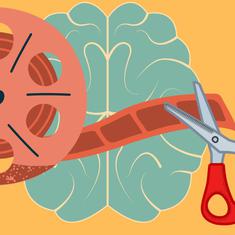I have an unusually soft spot for mysteries and murders set in islands, and have been fortunate enough to have read and watched some of the best on offer – Shetland (based on Ann Cleeves’ Jimmy Pérez books) and Agatha Christie’s And Then There Were None come to mind. Japanese authors, in particular, have mastered the art of delivering pitch-perfect island mysteries that utilise the unique environs to perfection – Yukito Ayatsuji’s Jukkakukan no Shinsou Kaiteiban (translated into English as The Decagon House Murders), Seishi Yokomizo’s Gokumon-tō (Prison Gate Island) or any of the several Kindaichi Shōnen no Jikenbo tales set on isles are only a few that promise a rollicking good time.
Ayatsuji’s 1987 novel The Decagon House Murders, a wonderfully original take on the Christie classic And Then There Were None, was a watershed moment in the annals of crime fiction writing in Japan. In it, Ayatsuji lays the foundations of what would later come to be known as the shin honkaku (new orthodox) school of mystery writing – a sub-genre that would, soon enough, lure amateur writers away from crafting social mysteries and later earn a legion of devoted fans whose admiration remains unsullied to this day. Early on in this book, one of the characters articulates what would essentially become a clarion call to future writers of this school. It is worth quoting in its entirety, especially as it aptly describes what the shin honkaku school stands for:
“In my opinion, mystery fiction is, at its core, a kind of intellectual puzzle. An exciting game of reasoning in the form of a novel. A game between the reader and the great detective, or the reader and the author. Nothing more or less than that.
So enough gritty social realism please. A female office worker is murdered in a one-bedroom apartment and, after wearing out the soles of his shoes through a painstaking investigation, the police detective finally arrests the victim’s boss, who turns out to be her illicit lover. No more of that! No more of the corruption and secret dealings of the political world, no more tragedies brought forth by the stress of modern society and suchlike. What mystery novels need are – some might call me old-fashioned – a great detective, a mansion, a shady cast of residents, bloody murders, impossible crimes and never-before-seen tricks played by the murderer. Call it my castle in the sky, but I’m happy as long as I can enjoy such a world. But always in an intellectual manner.”
The Moai Island Puzzle by Alice Arisugawa
In ways both good and bad, the essence of this lengthy, almost Queensian declaration is rendered faithfully in Alice Arisugawa’s 1989 work, Kotō Pazuru (literally, Koto Puzzle, translated into English in 2016 with the title of The Moai Island Puzzle). Just like its predecessor (The Decagon House Murders), The Moai Island Puzzle also has a university club of mystery fiction aficionados visiting a remote island that is soon cut off from the mainland by a raging storm, just as the island’s residents start getting knocked off one by one.
Three members of the Eito University Mystery Club – the narrator Alice, the sleuth Jirō Egami and the club’s only female recruit Maria Arima – visit Kashikijima on Maria’s invitation to indulge in treasure hunting. Kashikijima is a strange island – not only is it unusually shaped (it looks like a horseshoe magnet), it also has some 25 ominous moai statues looming large over the landscape. These statues also happen to be the focal point of the mysterious treasure – Maria’s grandfather hid a large cache of diamonds worth a fortune somewhere on the island with the only hint being the statues and the directions they faced. It is this seemingly unsolved mystery that Jirō and his friends wish to crack now.
There exist only two residences on Kakushijima, one each on the two poles of this horseshoe magnet island. The larger one, Panorama Villa, is hosting a gathering of Maria’s extended family members at the time of the mystery club’s arrival, while the smaller Happy Fish Villa is home to a moderately successful artist (also one of Maria’s relatives) who visits it from time to time. To travel from one to the other, one either needs to take a boat across the bay separating the two, or cover the distance on foot or bicycle courtesy of a road that takes one through the long arc of the island.
Both villas soon witness impossible crimes in the midst of a storm. Will Jirō and his friends be able to solve the puzzle of the treasure as well as that of the three murders that seem to have links with Maria’s past and one of her now deceased relatives?
At first glance, this synopsis seems very attractive, but I’ll start with the negatives here. The mystery surrounding the treasure, which lends itself to the title, is overlong and clearly overstays its welcome. Excessively laborious in its execution, one plods through this portion in weary anticipation of what they will find at the end of it all. Unfortunately, the puzzle of the statues ‘evolves’ too much for its own good – one definitely needs to be aware of a certain stream of knowledge to solve this puzzle, and even then, it’s quite a stretch to reach the correct conclusion.
Perhaps, even more damningly, the payoff is too little for all the struggle one undergoes, making for an extremely poor adventure trip – (spoiler alert) turns out the mystery has already been solved before the arrival of our protagonists, and then, the puzzle and the developments surrounding them essentially become a footnote in the motive behind the cases. Not fair at all, one would say, considering that nearly a 100 pages are devoted to this puzzle and its unravelling!
The first murder also happens pretty late into the novel, but it is the conversations between the (mostly dislikeable) characters preceding it and the way they are portrayed that proceeds to suck all the life away here. There is too much unnatural stiffness in the nature of the dialogue in this section – as though the characters too are eagerly waiting for something to happen to them and that they can’t wait any longer to reach the heart of the text.
The plot and the puzzles demand that the characters act in certain ways – and they do so, regardless of how unnatural, forced and even unrealistic it may all seem. While such a treatment on Arisugawa’s part clearly establishes the primacy of the plot and the puzzles over characterisation, a more competent balancing act would have gone a long way in making it palatable without leaving an unpleasant aftertaste.
A tribute to Queensian and Holmesian aesthetics
The novel really starts shining once the murders are committed. The Moai Island Puzzle is, at its best, a tribute to Queensian and Holmesian aesthetics in the mystery novel – and thankfully, the work provides many instances to showcase both. The Holmesian trait of eliminating all that’s impossible and positing whatever remains as the truth is evident in the many discussions between Jirō and his friends where hypotheses are presented and possibilities discounted by all three members of the Eito University Mystery Club, with Jirō acting as the most perceptive and discerning of the lot. And as Sōji Shimada astutely points out in his introduction to the novel, Jirō graduates from being a disinterested, bland, Queensian puzzle maniac to a more proactive Holmes-like figure who definitely acts heroically in a certain aspect towards the end of the novel. If only such a nuanced treatment could have been meted out to the rest of the characters. . .
Anyway, the novel does one better when doffing its hat to Ellery Queen. Chains of deduction are built upon minutely detailed timetables drawn by the investigators and very singular observations of particular items and events – (spoiler alert) a boat rown across the bay at a particular time, a light travelling between the two villas at the dead of night, a cycle tyre-mark and a piece of cloth found at particular parts of the island, among others – and linking them all into a linear, cohesive, and definitive narrative.
The novel is a perfect lesson in crafting chains of logical reasoning on singular observations, clues and items of evidence and also demonstrates why the author needn’t ‘deceive’ readers with a gamut of randomly scattered, possibly relevant clues and/or too many red herrings. It plays it very straight with the dying message too, which just requires one to understand what’s ‘not present’ to properly interpret it.
For those deeply vested in the world of Japanese crime novels, The Moai Island Puzzle can be considered to be mandatory reading. Personally, I find it a most instructive work that provides a fascinating glimpse into the highs and lows of shin honkaku plotting within the space of some 250-odd pages (notwithstanding the fact that it would have benefitted a lot if its length had been reduced by a third). Two different kinds of puzzles are presented in the work with conflicting treatments – one that the authors should aspire to, another they should avoid if they do not want to leave readers feeling short-changed. This, in itself, makes for a very strange balancing act – but one that should perhaps not be attempted at all.

Also read:
Can a detective novel study the evolution of a city through its history of crime and detection?
‘The Red Locked Room’: How Tetsuya Ayukawa unlocks locked room mysteries
How Keikichi Ōsaka blended crime with philosophical meditations on the puzzling nature of existence










